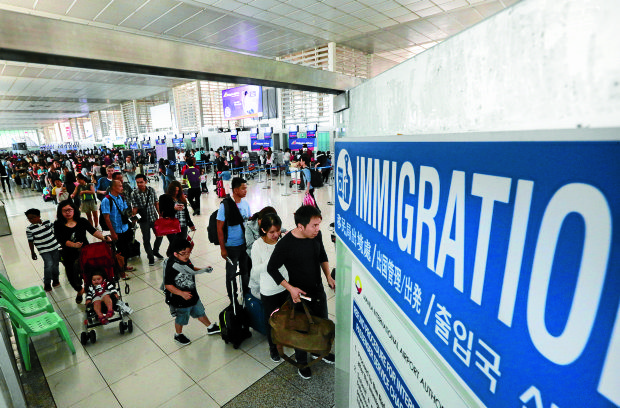
Passengers line up at the Immigration counters of the Ninoy Aquino International Airport (NAIA) in this April 10, 2017 photo. PHILIPPINE DAILY INQUIRER / GRIG C. MONTEGRANDE
The Bureau of Immigration (BI) has implemented a new biometrics system in a bid to detect and stop the entry of undesirable aliens to the country.
Called the Border Control Information System (BCIS), the biometrics-based technology is used in processing passengers entering and exiting the Philippines’ international airports.
BI commissioner Jaime Morente said the new software had been in place for the past two weeks at the Ninoy Aquino International Airport, after being tested in other airports across the country.
“Aside from speeding up passenger processing time, the system can detect attempts by fugitives and terrorists to enter the country, even if they if they are in disguise,” he said in a statement.
Morente said the BCIS is part of the BI’s efforts to upgrade its capabilities to detect and thwart the entry of undesirable aliens into the Philippines.
The BCIS uses computers equipped with cameras and finger scan devices that all passengers queued for immigration inspection must pass through every time they enter or leave the country.
“Each time a passenger’s face is captured by camera and his fingers scanned, the results are automatically cross-matched with the passport image and images in the BI database, where personal details of persons with derogatory records are stored,” Morente explained.
The BCIS was first pilot-tested in the international airports of Mactan-Cebu, Clark, Kalibo, Davao, and Laoag before it was introduced at the NAIA and other international ports across the country.
BI port operations division chief Marc Red Mariñas said the BCIS is also linked with the database of the Interpol and the Australian immigration department.
Individuals who are in those agencies’ wanted list will be caught if any of them attempted to enter the Philippines.
“With this system, the use of fraudulent travel documents and disguising one’s physical appearance will soon become inutile. The chances that they will not be caught is very slim,” Mariñas added. /cbb